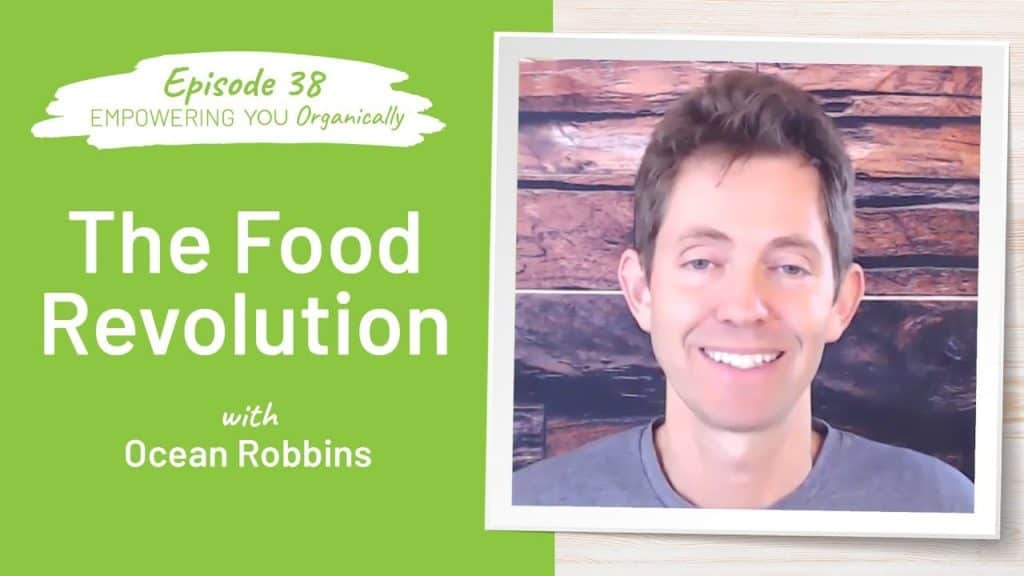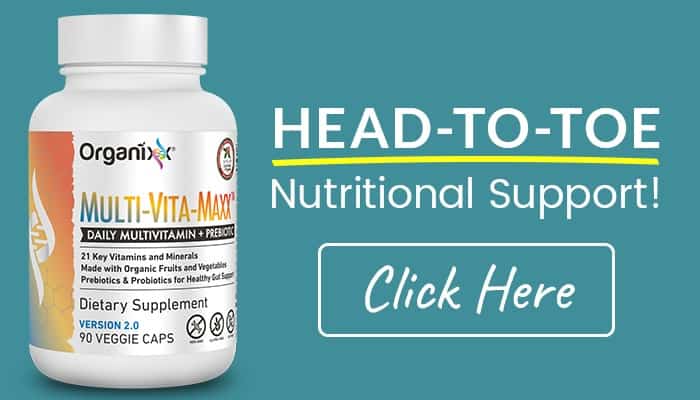Empowering you Organically- Season 6- Episode 38
Title: The Food Revolution and What You Need to Know About It
Hosts: Jonathan Hunsaker & TeriAnn Trevenen
Guest: Ocean Robbins
Description: Does your kitchen need a Food Revolution? Probably. A recent report concluded that the American diet killed 672,000 people in the United States last year. Worldwide, food is killing more than 11 million people per year, poor food choices. Tune in this week to hear Ocean Robbins explain how you can start your own Food Revolution today
About Ocean
Ocean Robbins is the author of the newly-released book, 31-Day Food Revolution: Heal Your Body, Feel Great, and Transform Your World. He serves as CEO and co-founder of the 500,000+ member Food Revolution Network, one of the largest communities of healthy eating advocates on the planet. Ocean has held hundreds of live seminars and events that have touched millions of lives in 190 nations.
His grandfather founded Baskin Robbins, and his father, John Robbins, walked away from the family company to write best-sellers, like Diet for A New America, and to become a renowned health advocate. Now, Ocean is on a mission to transform the industrialized food culture into one that celebrates and supports healthy people and a healthy planet.
* * *
The Standard American Diet
When we follow the standard American diet, we get the standard American diseases.
YES!
- Youth for Environmental Sanity
- Ocean founded as a teen.
- Mission: Empower young people to stand up for healthy lives and a healthy world.
Food Revolution Network
- Co-founded with father, John Robbins, eight years ago.
- Mobilizing people all over the planet, millions of people, for healthy, ethical, sustainable food.
- Food is medicine, or it can also be poison.
- Unfortunately, the way that we’re eating today is literally like digging our own graves with our knives and forks.
- Our mission in Food Revolution Network is very literally to save lives and to help more people to have this life-saving information.
- “No, it’s not about genetics, it’s not about luck, and we don’t have to be victims here, it’s about the choices we make, and we can radically improve our health just by making different choices.”
- Our goals:
- To share the information
- To help everybody have the clarity and the action so that they can get the results they want.
Global Burden of Disease
- A report produced by the Institute of Health Metrics and Evaluation.
- Researchers at University of Washington lead this.
- Every year, they review the major causes of death and disease in basically every country in the world, and they analyze hundreds of causes of death and disease, and they analyze what people are dying from, and they look at all the data.
- Their most recent report concluded that the American diet killed 672,000 people in the United States last year. Worldwide, food is killing more than 11 million people per year, poor food choices.
- In the US alone, we have more deaths from what we’re eating than the number of Americans who died in World War 1, World War 2, both Iraq wars, Afghanistan War, Vietnam War, Korean War, combined.
31-Day Food Revolution
- Ocean’s effort to put all this knowledge into a distilled form so you can take action.
- There are 31 chapters in 31-Day Food Revolution. Each one ends with simple steps you can take to put what you’re learning into action in generally a few minutes, and you can get results, and you can make progress.
- “In the long run, 31 steps to health will bring you more pleasure, even than 31 flavors of ice cream.” ~Ocean
- “I wrote this book specifically to help everybody who wants to take these steps, to make it easy and effective and doable.” ~Ocean
What’s Your Destination?
- The critical components of any journey are you look at where you are, you look at where you’re going, and then you create a map for that route.
- Clarify what your motivation is, what your big “WHY” is, what your goals are, what you’re going for.
- Do you want to fight disease?
- Do you want to optimize your health?
- Do you want to have more muscle?
- Do you want to look good?
- Do you want to feel good?
- Do you want to do good?
- Social impact/environmental impact.
- A lot of us want to be healthy, we want to fight disease, and we want to contribute to a healthier world, all at the same time. And it turns out, that with food, you can do all of that.
Core Principles
- Eat less sugar and processed junk.
- Eat less animal products, especially when they come from factory farms.
- Eat more whole plant foods.
- Conscious sourcing.
- It matters where your food comes from, it matters how it was produced, it matters if it was genetically engineered, or saturated with neurotoxic pesticides, or full of hormones and antibiotics, or if it was produced in a clean way with respect for the earth and respect for your health.
Steps Towards Progress
- Clear out your cupboards.
- Make a good shopping list of some healthy stuff and fill your cupboards and your fridge with good stuff that’s actually healthy.
- Find some recipes that are healthy, that are wholesome, that are nourishing.
- Create safety nets by having healthy foods available at all times, that are ready to go.
Tips for Eating Healthy
- The most expensive calories you will ever eat are the ones that make you sick.
- The second most expensive calories that we ever consume are the ones that we waste because we don’t eat them, because they’re excess calories.
-
- The average American is eating about 500 calories a day too much.
- We want to steer clear of excess restaurants because a lot of eating out costs a premium.
- Go organic with the dirty dozen.
-
- The most pesticide-contaminated foods, according to Environmental Working Group are what they call the “Dirty Dozen.”
- The Environmental Working Group has what they call the “Clean 15,” which are the foods that are the least pesticide-contaminated.
- Cooking in quantity
- When you’re stressed out, you’re more likely to eat out, you’re more likely to grab convenience foods.
- Don’t ever just make one meal at a time, at least with your staples.
- Pay it forward and prepare.
- Cook extra for people you love in your community.
Why Healthy Food Costs More
- We actually have a government subsidy system in place right now, where the US taxpayer, we subsidize junk food with tens of billions of dollars a year, subsidizing what’s called commodities crops.
-
- Twinkies
- Wonder Bread
- High-fructose corn syrup
- Factory-farmed meat
- Corn
- Soy
- Wheat
- If an organically-certified farmer wants to get that certification, they’ve got to pay for the regulatory burden in order to be certified. And somebody who’s dousing their field with pesticides doesn’t have as much of a regulatory burden as the organic farmer, who’s doing the right thing.
CSA
- Community-Supported Agriculture
- Every week, we get a big order of whatever the farm has available.
Humane Food Sources
- If you’re going to eat meat, then better meat.
- Make sure it’s coming from pasture-raised or grass-fed animals.
- Organic means that an animal was not given hormones or antibiotics and was fed organic feed. It doesn’t mean it lived humanely.
- Chickens
- A regular bird might have been given 1 square foot.
- A cage-free bird might be given 1 ½ square feet.
- Free-range might be 2 ½ square feet.
- Pasture-raised means 108 square feet.
- Grass-fed means cows actually ate grass instead of grain and soybeans, which inherently means they have to be outside.
- From an environmental resource standpoint, meat takes more resources, because any time you move up the food chain, animals need a certain amount of calories that they have to consume, and they’re going to produce less calories, because some of it’s going to go to hoof and hide and bone and energy the animal uses to move, and manure.
- There’s a certain amount of grazing lands that are growing grass, and well-managed livestock can graze on that land sustainably when it’s done in certain ecosystems.
- The factory farming system is profoundly cruel. Animals are being pumped full of hormones and antibiotics just to keep them alive under despicable conditions.
- USDA organic certification
- Fish
- A lot of our fish is coming from farms.
- It takes five pounds of seafood to make one pound of a farmed fish.
- They’re putting antibiotics into the water, so the fish don’t die.
- They’re adding pink color to farmed salmon’s water so that it won’t be grey because they’re not feeding it its natural diet.
- There are some farms that are doing things better, but it’s not regulated right now.
Is There Hope?
- Food is changing, and we get to be a part of it.
- As bad as things are, that’s how much better they can be with a change.
- Sales of organic food, sales of non-GMO food, sales of natural foods, are all skyrocketing.
- Community-supported agriculture programs are growing.
- Farmer’s markets are growing.
- More and more people care where that food comes from, how it was produced.
- Young people are starting to take an interest in growing food again. More and more kids are getting involved in growing food.
- In the United States, we’ve had a steady decline in the number of farms in America over the course of the last century. In the last few years, that’s started to tip back the other way.
- There are more and more community gardens, more and more church gardens, more and more school gardens.
- When you make a healthier food choice for yourself, you actually start to redirect your dollars, and you start to change the way food is grown, there becomes a higher demand for that healthier food, and then farmers start to plant different crops, and more farmers get with the program.
- The food industry is changing as well. These companies are having to diversify. The way they’re doing it, interestingly enough, is by buying up the natural foods industry.
Giving Back
- Trees for The Future
- “We actually fund the planting of an organic food or nut tree in a low-income community with every single product we ever sell.” ~Ocean
One Last Word
“Food matters. So, make every bite count.”
* * *
Subscribe to Empowering You Organically
Never miss an episode!
APPLE PODCASTS SPOTIFY GOOGLE PODCASTS
–
Episode 38 – The Food Revolution and What You Need to Know About It




